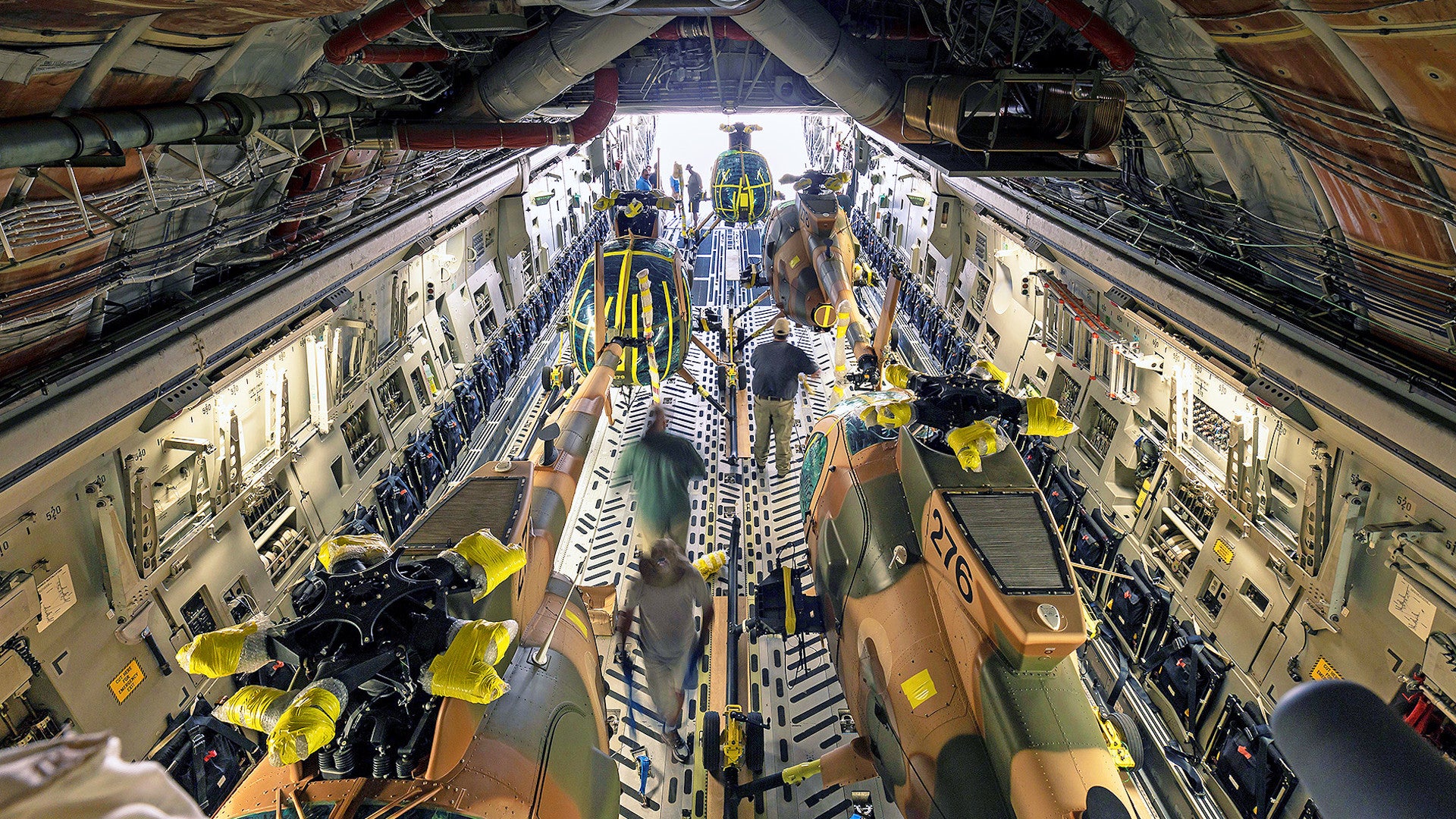A total of 24 helicopters that once belonged to the defunct Afghan Air Force are now at the U.S. military’s main aircraft boneyard at Davis-Monthan Air Force Base in Arizona. Over the past few weeks, an additional four Russian-made Mi-17 Hip transports and 17 MD 530F Little Bird armed light helicopters have joined the three Mi-17s that arrived last month. The War Zone
was first to report on the delivery of that initial trio.
Air Force Materiel Command’s (AFMC) public affairs office provided this update on how many ex-Afghan Air Force aircraft are at the boneyard to The War Zone. AFMC had previously explained that the U.S. Defense Security Cooperation Management Office-Afghanistan, which is headquartered in Qatar, is overseeing the consolidation of these airframes at Davis-Monthan.

It is not clear how many former Afghan Air Force Mi-17s, MD 530Fs, or other types that had belonged to that service the U.S. military ultimately plans to relocate to Arizona. As of July, the month before the fall of Afghanistan to the Taliban, the Afghan Air Force had 13 Mi-17s and 49 MD 530Fs, according to the Special Inspector General for Afghanistan Reconstruction (SIGAR), a U.S. government watchdog.

However, at that same time, SIGAR acknowledged that this was not necessarily a complete accounting of the full Afghan inventories of either of those helicopters. For instance, the Afghan military’s Special Mission Wing, a separate, secretive special operations aviation unit — data about which remains classified — operated at least some number of Mi-17s. Furthermore, SIGAR subsequently said that at least six helicopters, a mixture of both Hips and UH-60A+ Black Hawks, were overseas undergoing maintenance at the time of the Taliban takeover. Afghan media reports had suggested the total number of Afghan Air Force aircraft being repaired in other countries might have been as high as 25, according to the watchdog.
In addition, satellite imagery that The War Zone had obtained from Planet Labs in August showed at least 19 Mi-17-type helicopters at Termez Airport in Uzbekistan, where various Afghan Air Force aircraft had fled in the face of the Taliban conquest. While it was later determined that some of the Hips at Termez belonged to the Uzbek government, the bulk of them did not. Other ex-Afghan Air Force aircraft escaped to Tajikistan, but Mi-17s or any other kinds of helicopters do not appear to have been among them. The Taliban is known to have captured at least 12 more Mi-17s, in various states of airworthiness, as well. All this makes clear that the total number of Hips alone in the Afghan military’s inventory prior to its collapse was clearly significantly higher than SIGAR had previously reported and otherwise calls into question the completeness of the data available to them.

Regardless, it is clear the U.S. government continues to be under immense pressure to recover as many ex-Afghan Air Force aircraft of all types as possible, or otherwise prevent the repatriation of any airframes that are still in other countries back to the current Taliban-controlled government of Afghanistan. The total number of former Afghan aircraft in storage at Davis-Monthan is likely to grow even further in the near term.
The 24 helicopters there now could eventually be joined by some number of Black Hawks. It is somewhat curious that no UH-60s have arrived the boneyard already. This raises the possibility that those aircraft might be going to wherever the U.S. military is storing dozens of other examples that were earmarked for the Afghan Air Force, but never delivered. SIGAR previously reported that 37 Black Hawks that had been destined for Afghanistan were still at an unspecified location in the United States when the country’s government collapsed in August.

Portions of that service’s fixed-wing inventory, which included A-29 light attack aircraft, AC-208 armed light utility planes, Cessna 208 Caravan small transports, and Pilatus PC-12NG intelligence, surveillance, and reconnaissance platforms, could make their way to Arizona, too.
What might happen to any of the aircraft that ultimately end in the boneyard remains to be seen. By and large, the Afghan Air Force operated types that are not in widespread U.S. military service. That being said, Mi-17-type helicopters are notably in use by highly secretive U.S. military special operations units and the Central Intelligence Agency. These organizations could be interested in acquiring some of these former Afghan examples. There have been reports that President Joe Biden’s administration has been considering transferring some to the Ukrainian military, which operates Hips, as part of possible new military aid packages to that country as it faces the prospect of a new large-scale Russian invasion.
In recent years, the U.S. military has been heavily promoting MD 530 variants as options for allies and partners looking to acquire armed light helicopters through established foreign assistance mechanisms, such as the Foreign Military Sales (FMS) process. Lebanon, for example, just recently began taking delivery of a fleet of MD 530Fs via FMS that are set to become part of a special operations aviation element in that country. So, the former Afghan Air Force helicopters could very well end up resold to other countries.

With no ex-Afghan fixed-wing types delivered to the boneyard yet, it’s harder to speculate about the future of any such aircraft, but A-29s and Cessna 208 Caravan variants have also been popular options for sale through FMS and other U.S. foreign security assistance programs. Afghanistan’s PC-12NGs, all of which were operated by the Special Mission Wing, were supplied in a sensitive configuration the exact capabilities of which remain something of a mystery. This could make transferring those aircraft to other allies or partners a more complex affair.
In the end, at least some of the ex-Afghan Air Force aircraft that the U.S. government recovers may just end up disappearing into obscurity at the boneyard, which is already home to hundreds of other aircraft that will likely never fly again.
Contact the author: joe@thedrive.com
